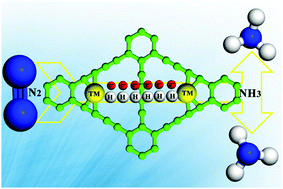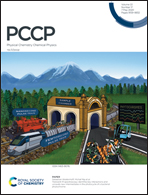Graphdiyne coordinated transition metals as single-atom catalysts for nitrogen fixation†
Abstract
The reduction of N2 molecules to NH3 is a very challenging task in chemistry. The electrocatalytic nitrogen reduction reaction (NRR) is a promising technology for NH3 synthesis. By using first-principles calculation, a new class of single-atom catalysts (SACs), graphdiyne coordinated single transition metal atoms (TM@GDY, TM = Sc–Zn, Y–Cd, and La–Hg) were designed, and the NRR catalytic character of TM@GDY was systematically investigated. The results demonstrated that some TM@GDY (TM = Ti, V, Fe, Co, Zr, Rh, and Hf) monolayers exhibit better NRR activities than a Ru(0001) stepped surface. There is an obvious linear correlation between the limiting potential and the atomic N adsorption energy, which confirms that the N adsorption energy may be a descriptor for evaluation of the NRR catalytic performance. The V@GDY monolayer possesses the best NRR catalytic character with the lowest limiting potential of −0.67 V and the potential-limiting step (PLS) of *N2 → *NNH for both alternating and distal mechanisms. Our results highlight a new family of efficient and stable TM@GDY catalysts and provide useful guidelines for SAC development and practical applications.



 Please wait while we load your content...
Please wait while we load your content...